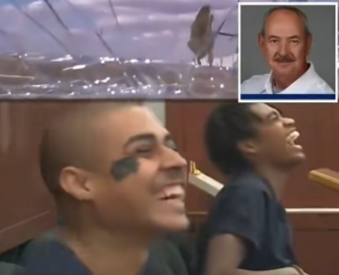
“Chaos at the Gate: Bomb Threat, Stabbing and a Moment of Terror Caught on Camera”
What starts as a frantic scene quickly spirals into a nightmare. In grainy footage of a recent incident, voices shout warnings, people scramble, and a tense crowd watches a single man—accused of carrying explosives—become the center of a deadly confrontation. The short audio clips play like a horror movie script: “Everybody else get back… he has a bomb,” someone shouts. Panic ripples through the crowd as others beg people to move away.
Eyewitness audio suggests a violent lead-up: “Instead of going to school they stabbed him,” someone reports in disbelieving fragments, while another voice warns that the man is trying to detonate himself. Repeated cries of “Get the fuck away” and “He’s got bombs attached to him” underscore the raw fear in the moment. Seconds stretch into an eternity as bystanders plead for restraint—“Come on, don’t shoot him”—even as the situation teeters on the brink of catastrophe.
The recording climaxes with the sound of chaos collapsing into sudden silence: “He’s dead on the floor,” a stunned voice says, followed by breathless exclamations. Whether the man died from the alleged stabbing, from police intervention, or by his own hand remains unclear from the audio alone. What is undeniable is the scale of terror inflicted on everyone nearby—children, commuters, or shoppers who found themselves unexpectedly trapped in an impossible decision: run, help, or hide.
Authorities are reported to have cordoned off the area and launched an immediate investigation. For residents and onlookers, the incident is a traumatic reminder of how quickly public spaces can become scenes of life-or-death chaos. Community leaders are calling for calm and urging witnesses to come forward while officials piece together a timeline that could explain motive, connections, and whether this was an isolated event or part of a broader scheme.
Beyond the facts investigators will eventually establish, the human cost is already visible: shaken families, terrified witnesses, and a neighborhood left searching for answers. For those who heard the terrified voices on the tape—pleading, warning, helpless—the recording is not just evidence; it’s a chilling document of a fragile moment when ordinary life teetered on the edge of annihilation.
As the investigation continues, the recording remains a stark testament to how thin the line can be between ordinary routine and sudden terror.



